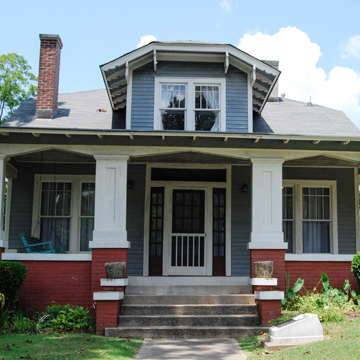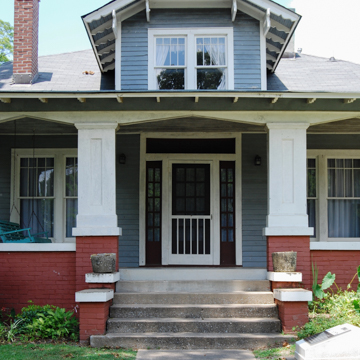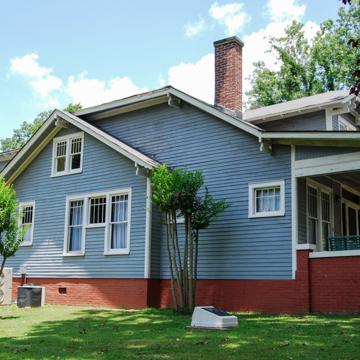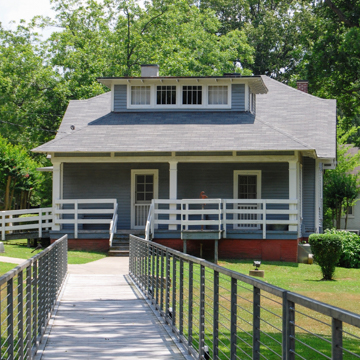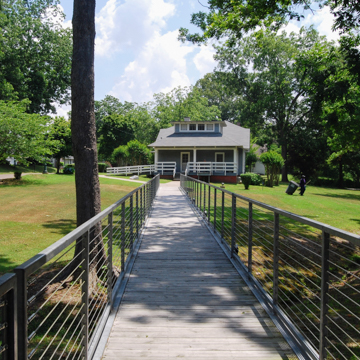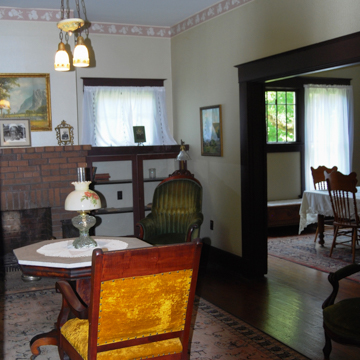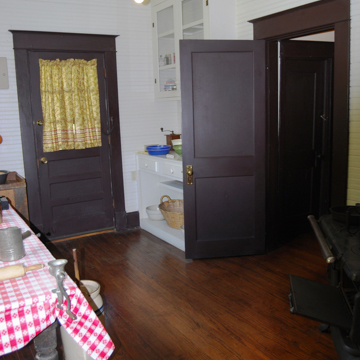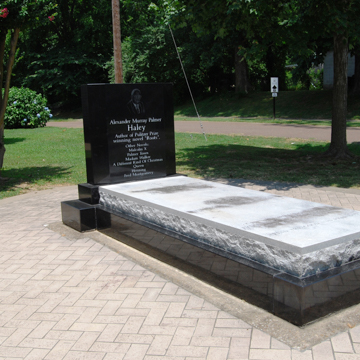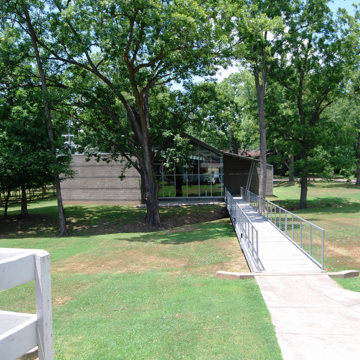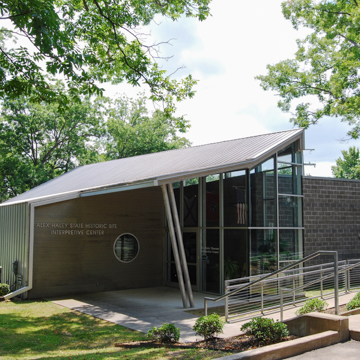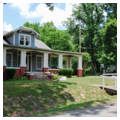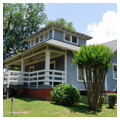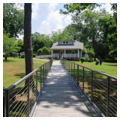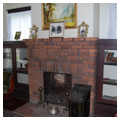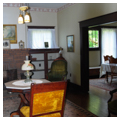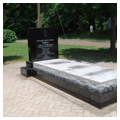You are here
Alex Haley Museum and Interpretive Center
The Alex Haley Museum is the boyhood home of Alexander Palmer Murray Haley (1921–1992), the Pulitzer Prize–winning author of Roots: The Saga of an American Family (1976). It was on the front porch of this 1919 bungalow that young Haley first learned about his ancestors. Built in 1918–1919, the Craftsman bungalow is also notable as the residence of Will E. Palmer, a prosperous African American businessman, owner of the W.E. Palmer Lumber Company.
Alex Haley’s great-great grandfather came with other freedmen to the small community of Henning, Tennessee, in the late nineteenth century. Haley’s maternal grandparents, Will E. and Cynthia Palmer, were married in the church built by these freedmen. Will Palmer worked at a local lumberyard before purchasing the establishment around 1893. In the succeeding years, Palmer became a prosperous businessman—despite the restrictions of the Jim Crow era. In 1918 he built this ten-room, weatherboard-sided Craftsman house on Church Street.
The one-and-one-half-story frame residence is located in a verdant neighborhood of bungalows and ranch houses. It is covered with a jerkinhead roof and a prominent jerkinhead dormer over the entrance. Sturdy paneled columns delineate the porch and porte cochere. Other Craftsman features include multi-light windows and a main entry with transom and sidelights. The house was built with a music room and may have had a library. A brick fireplace, built-in bookcases, and paneled trim complete the interior. There are seven rooms on the first floor and three above. As typical with bungalows, the parlor is the largest room on the main floor and the kitchen is at the rear.
Haley was born in Ithaca, New York, where his father Simon was working on a degree in agriculture at Cornell and his mother Bertha was a student at the Ithaca Conservatory of Music. His parents met at Lane College in Jackson, Tennessee, and married in Henning in 1920, shortly after the bungalow was finished. When Haley was less than a year old, Bertha returned with her son to Henning, where the two lived with Bertha’s parents; Simon stayed in Ithaca to finish his degree. After his return to Henning, Simon operated the Palmer family business until circa 1929, when he moved his family in order to begin his teaching career at North Carolina Agricultural and Technical State University. Haley and his siblings returned to Henning often and they considered the bungalow home until it left the family circa 1957–1959.
Haley attended Alcorn State University in Mississippi and Elizabeth City State College in North Carolina, but never finished a degree, choosing instead to enter the U.S. Coast Guard in 1939, where he would remain until 1959. While he was still serving in the Coast Guard, Haley began writing for Reader’s Digest and he continued to write for the magazine into the 1960s. In 1963, Reader’s Digest sent him to interview Nation of Islam leader Malcolm X. The result was The Autobiography of Malcolm X, published in 1965. Haley also published prominent interviews in Playboy magazine, including those with jazz musician Miles Davis and civil rights leader Reverend Dr. Martin Luther King Jr.
Though Haley’s grandfather died when Alex was only five years old, and his mother died when he was eleven, the influence of his grandmother, Cynthia Palmer, was strong, and the stories that she and relatives like Sis Brooks and Elizabeth Murray told him stayed with Alex for many years, eventually prompting him to travel in the late 1960s to the village of Juffure in Gambia. This led him to more tales of his ancestors. When combined with those he heard in Henning, Haley established a narrative connecting his ancestors across two continents and more than two centuries— Roots was the result. First excerpted in Reader’s Digest, the book became a bestseller after its 1976 publication and, in 1977, an ABC mini-series that was watched by more than ninety million viewers. Despite subsequent controversies, Roots was a landmark publication that had an impact far greater than one family’s story.
In 1979, in the midst of his Roots success, Haley purchased the Palmer House with the idea of turning it into a museum. In 1985, the state appropriated funds for the house to become a state-owned historic site under the auspices of the Tennessee Historical Commission. Since 1985, the property has been restored to the time when Haley visited regularly. Haley died in 1992 and is buried on the Palmer House property.
In 2010 a new Interpretive Center opened at the back of the property. It showcases the history of the Palmer and Haley families and displays their artifacts. Designed by the Memphis architectural firm Askew Nixon Ferguson, the building received an AIA Gulf States Region Merit Award, an AIA Tennessee Award of Excellence, a Masonry Institute of Tennessee Award, and first place in the MetalMag Architectural Awards Merit Award. The 6,500-square-foot, one-story masonry and glass building has a flat and sloping metal roof, open floor plan, and connects to the Palmer House by a walkway. The Interpretive Center was designed and oriented with a sightline towards the historic house.
References
“Alex Haley Biography.” Biography.com. Accessed April 5, 2018. http://www.biography.com/.
Dalton, Robert E., “Palmer, W.E., House,” Lauderdale County, Tennessee. National Register of Historic Places Registration Form, 1977. National Park Service, U.S. Department of the Interior, Washington, D.C.
Haley, Alex. “My Furthest–Back Person—‘The African’.” New York Times Magazine, July 16, 1972.
“Haley Buys Home.” Lauderdale County Enterprise, October 4, 1979.
“Haley Home Called Good for Tourism.” Memphis Commercial Appeal, April 30, 1985.
“Historic Site Planned.” The Courier XXVI, no. 1 (October 1985).
Writing Credits
If SAH Archipedia has been useful to you, please consider supporting it.
SAH Archipedia tells the story of the United States through its buildings, landscapes, and cities. This freely available resource empowers the public with authoritative knowledge that deepens their understanding and appreciation of the built environment. But the Society of Architectural Historians, which created SAH Archipedia with University of Virginia Press, needs your support to maintain the high-caliber research, writing, photography, cartography, editing, design, and programming that make SAH Archipedia a trusted online resource available to all who value the history of place, heritage tourism, and learning.














